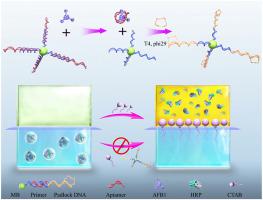Analytica Chimica Acta ( IF 6.2 ) Pub Date : 2022-06-09 , DOI: 10.1016/j.aca.2022.340065 Wenli Wu 1 , Shuang Xia 1 , Mei Zhao 1 , Jiantao Ping 1 , Jin-Ming Lin 2 , Qiongzheng Hu 1

|
The detection of AFB1 that is a group I carcinogen is significantly important for food safety. Herein, we report a colorimetric liquid crystal (LC)-based assay that allows the ultrasensitive detection of AFB1. When an aqueous solution of a cationic surfactant is transferred onto the LCs dispersed with the aqueous microdroplets containing the anionic surfactants and horseperoxidase (HRP), it triggers the release of HRP due to the interfacial charge interaction. Because HRP can catalyze the colorless 3,3′-5,5′-tetramethylbenzidine (TMB) into yellow products, the response of the LCs dispersed with the aqueous microdroplets to the cationic surfactant is visually determined. In the presence of AFB1, the rolling circle amplification on magnetic beads (MBs) is triggered due to the specific recognition of AFB1 by its aptamer, which results in the generation of long chain single-stranded DNA on MBs. As the cationic surfactants are captured by the negatively charged ssDNA, it prevents the release of HRP into the aqueous solution. In contrast, in the absence of AFB1, HRP is released into the aqueous solution. The developed AFB1 sensing assay shows very good linear relationship with the detection limit of AFB1 determined to be as low as 0.014 pg/mL. In addition, the detection of AFB1 in rice and peanut oil is also examined to demonstrate its capability for the analysis of the real samples. Overall, this method takes advantages of the unique aptamer/target recognition, specific enzymatic reaction, and simple colorimetric assay, which makes it very promising for the ultrasensitive detection of AFB1 in practical applications.
中文翻译:

基于比色液晶的测定法在滚环扩增辅助下超灵敏检测 AFB1
作为 I 类致癌物的 AFB1 的检测对食品安全具有重要意义。在这里,我们报告了一种基于比色液晶 (LC) 的检测方法,可以超灵敏地检测 AFB1。当阳离子表面活性剂的水溶液转移到分散有含有阴离子表面活性剂和马过氧化物酶 (HRP) 的水性微滴的 LC 上时,由于界面电荷相互作用,它会触发 HRP 的释放。由于 HRP 可以催化无色 3,3'-5,5'-四甲基联苯胺 (TMB) 生成黄色产物,因此可以目测确定用水性微滴分散的 LC 对阳离子表面活性剂的响应。在存在 AFB1 的情况下,由于 AFB1 的适体特异性识别,触发了磁珠 (MB) 上的滚环扩增,这导致在 MB 上产生长链单链 DNA。由于阳离子表面活性剂被带负电荷的 ssDNA 捕获,它可以防止 HRP 释放到水溶液中。相反,在没有 AFB1 的情况下,HRP 被释放到水溶液中。开发的 AFB1 传感测定与 AFB1 的检测限显示出非常好的线性关系,确定低至 0.014 pg/mL。此外,还检查了大米和花生油中 AFB1 的检测,以证明其分析实际样品的能力。总体而言,该方法具有独特的适体/靶标识别、特异性酶促反应和简单的比色测定等优点,使其在实际应用中对AFB1的超灵敏检测非常有前景。由于阳离子表面活性剂被带负电荷的 ssDNA 捕获,它可以防止 HRP 释放到水溶液中。相反,在没有 AFB1 的情况下,HRP 被释放到水溶液中。开发的 AFB1 传感测定与 AFB1 的检测限显示出非常好的线性关系,确定低至 0.014 pg/mL。此外,还检查了大米和花生油中 AFB1 的检测,以证明其分析实际样品的能力。总体而言,该方法具有独特的适体/靶标识别、特异性酶促反应和简单的比色测定等优点,使其在实际应用中对AFB1的超灵敏检测非常有前景。由于阳离子表面活性剂被带负电荷的 ssDNA 捕获,它可以防止 HRP 释放到水溶液中。相反,在没有 AFB1 的情况下,HRP 被释放到水溶液中。开发的 AFB1 传感测定与 AFB1 的检测限显示出非常好的线性关系,确定低至 0.014 pg/mL。此外,还检查了大米和花生油中 AFB1 的检测,以证明其分析实际样品的能力。总体而言,该方法具有独特的适体/靶标识别、特异性酶促反应和简单的比色测定等优点,使其在实际应用中对AFB1的超灵敏检测非常有前景。相反,在没有 AFB1 的情况下,HRP 被释放到水溶液中。开发的 AFB1 传感测定与 AFB1 的检测限显示出非常好的线性关系,确定低至 0.014 pg/mL。此外,还检查了大米和花生油中 AFB1 的检测,以证明其分析实际样品的能力。总体而言,该方法具有独特的适体/靶标识别、特异性酶促反应和简单的比色测定等优点,使其在实际应用中对AFB1的超灵敏检测非常有前景。相反,在没有 AFB1 的情况下,HRP 被释放到水溶液中。开发的 AFB1 传感测定与 AFB1 的检测限显示出非常好的线性关系,确定低至 0.014 pg/mL。此外,还检查了大米和花生油中 AFB1 的检测,以证明其分析实际样品的能力。总体而言,该方法具有独特的适体/靶标识别、特异性酶促反应和简单的比色测定等优点,使其在实际应用中对AFB1的超灵敏检测非常有前景。还检查了大米和花生油中 AFB1 的检测,以证明其分析实际样品的能力。总体而言,该方法具有独特的适体/靶标识别、特异性酶促反应和简单的比色测定等优点,使其在实际应用中对AFB1的超灵敏检测非常有前景。还检查了大米和花生油中 AFB1 的检测,以证明其分析实际样品的能力。总体而言,该方法具有独特的适体/靶标识别、特异性酶促反应和简单的比色测定等优点,使其在实际应用中对AFB1的超灵敏检测非常有前景。



























 京公网安备 11010802027423号
京公网安备 11010802027423号